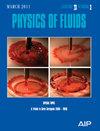Magnetic field-mediated ferrofluid droplet deformation in extensional flow
IF 4.1
2区 工程技术
Q1 MECHANICS
引用次数: 0
Abstract
Extensional flow is vital in droplet dynamics, influencing their formation, size, stability, and functionality across diverse applications from industrial processes to biomedical technology. Ferrofluid droplets are pivotal in many such applications, where magnetic fields enable non-contact manipulation without undesirable heating effects. However, controlling ferrofluid droplet dynamics in magnetically influenced extensional flows is challenging due to the complex interplay of induced magnetization, intrinsic magnetic properties, and flow kinematics. Here, we present a first-principle-based theory delving into the morphology of a ferrofluid droplet under the combined influence of an external magnetic field and extensional flow. Unlike previous studies, we employ an asymptotic analysis that delves on the shape alterations by considering local magnetization as dependent on magnetic field intensity. Additionally, we develop a numerical model based on phase-field hydrodynamics to establish the practical applicability of the asymptotic solution and to explore large droplet-deformation regimes. The study demonstrates that increasing the magnetic field intensity, the saturation magnetization of the ferrofluid, and the initial magnetic susceptibility each independently improve droplet deformation. Additionally, we found that in a uniform magnetic field, the extensional viscosity of a ferrofluid emulsion is influenced by the strain rate, leading to strain-thickening behavior in the dilute emulsion. Our findings offer new insights into field-assisted manipulation of ferrofluid droplets, emphasizing their potential in applications ranging from process engineering to biomedical technology.延伸流中磁场介导的铁流体液滴变形
扩展流在液滴动力学中至关重要,它影响着液滴的形成、大小、稳定性和功能性,应用范围从工业流程到生物医学技术。铁流体液滴在许多此类应用中至关重要,磁场可实现非接触式操作,而不会产生不良的加热效应。然而,由于诱导磁化、固有磁特性和流动运动学之间复杂的相互作用,在受磁影响的伸展流动中控制铁流体液滴的动力学具有挑战性。在此,我们提出了基于第一原理的理论,深入研究了铁流体液滴在外加磁场和延伸流共同影响下的形态。与以往的研究不同,我们采用了渐近分析法,通过考虑局部磁化与磁场强度的关系来深入研究形状的改变。此外,我们还开发了一个基于相场流体力学的数值模型,以确定渐近解的实际适用性,并探索大液滴变形机制。研究表明,增加磁场强度、铁流体的饱和磁化率和初始磁感应强度可分别独立地改善液滴变形。此外,我们还发现,在均匀磁场中,铁流体乳液的延伸粘度受应变率的影响,从而导致稀乳液的应变增厚行为。我们的发现为现场辅助操纵铁流体液滴提供了新的见解,强调了它们在从工艺工程到生物医学技术等领域的应用潜力。
本文章由计算机程序翻译,如有差异,请以英文原文为准。
求助全文
约1分钟内获得全文
求助全文
来源期刊

Physics of Fluids
物理-力学
CiteScore
6.50
自引率
41.30%
发文量
2063
审稿时长
2.6 months
期刊介绍:
Physics of Fluids (PoF) is a preeminent journal devoted to publishing original theoretical, computational, and experimental contributions to the understanding of the dynamics of gases, liquids, and complex or multiphase fluids. Topics published in PoF are diverse and reflect the most important subjects in fluid dynamics, including, but not limited to:
-Acoustics
-Aerospace and aeronautical flow
-Astrophysical flow
-Biofluid mechanics
-Cavitation and cavitating flows
-Combustion flows
-Complex fluids
-Compressible flow
-Computational fluid dynamics
-Contact lines
-Continuum mechanics
-Convection
-Cryogenic flow
-Droplets
-Electrical and magnetic effects in fluid flow
-Foam, bubble, and film mechanics
-Flow control
-Flow instability and transition
-Flow orientation and anisotropy
-Flows with other transport phenomena
-Flows with complex boundary conditions
-Flow visualization
-Fluid mechanics
-Fluid physical properties
-Fluid–structure interactions
-Free surface flows
-Geophysical flow
-Interfacial flow
-Knudsen flow
-Laminar flow
-Liquid crystals
-Mathematics of fluids
-Micro- and nanofluid mechanics
-Mixing
-Molecular theory
-Nanofluidics
-Particulate, multiphase, and granular flow
-Processing flows
-Relativistic fluid mechanics
-Rotating flows
-Shock wave phenomena
-Soft matter
-Stratified flows
-Supercritical fluids
-Superfluidity
-Thermodynamics of flow systems
-Transonic flow
-Turbulent flow
-Viscous and non-Newtonian flow
-Viscoelasticity
-Vortex dynamics
-Waves
 求助内容:
求助内容: 应助结果提醒方式:
应助结果提醒方式:


